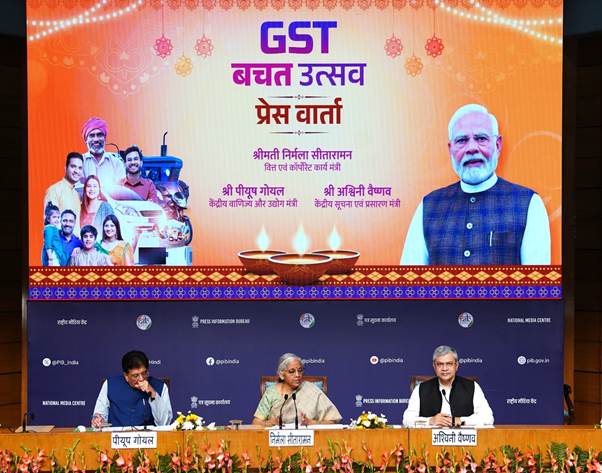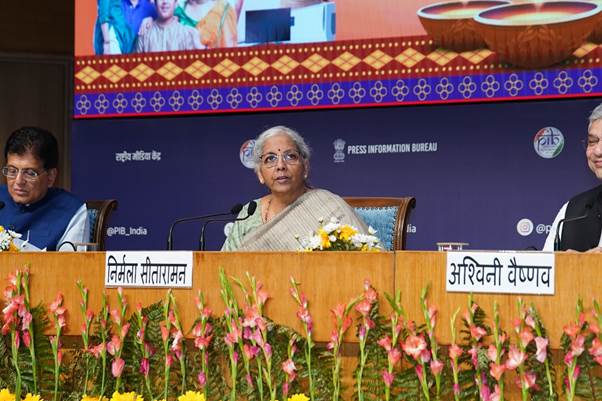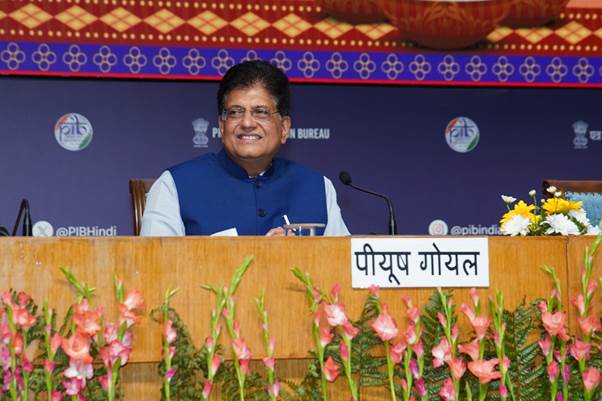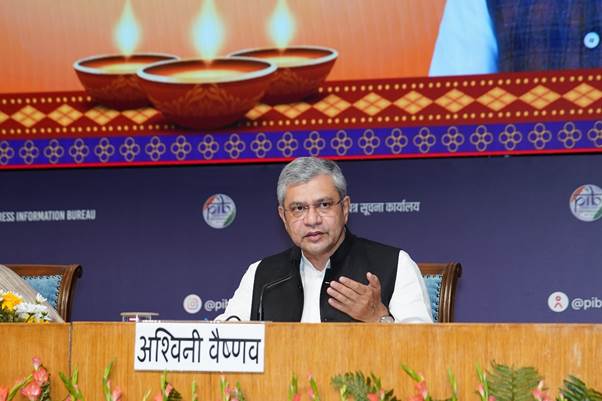Union Minister for Finance and Corporate Affairs Smt. Nirmala Sitharaman; Union Minister for Commerce and Industry Shri Piyush Goyal; and Union Minister for Minister for Railways, Information & Broadcasting, Electronics & Information Technology Shri Ashwini Vaishnaw hold joint press conference on GST Bachat Utsav in New Delhi, today
Union Minister for Finance and Corporate Affairs Smt. Nirmala Sitharaman; Union Minister for Commerce and Industry Shri Piyush Goyal; and Union Minister for Minister for Railways, Information & Broadcasting, Electronics & Information Technology Shri Ashwini Vaishnaw hold joint press conference on GST Bachat Utsav in New Delhi, today
Union Minister for Finance and Corporate Affairs Smt. Nirmala Sitharaman; Union Minister for Commerce and Industry Shri Piyush Goyal; and Union Minister for Minister for Railways, Information & Broadcasting, Electronics & Information Technology Shri Ashwini Vaishnaw held a joint press conference on GST Bachat Utsav in New Delhi, today.

In her opening remarks, Smt. Nirmala Sitharaman said that the Prime Minister Shri Narendra Modi had announced from the Red Fort that Next-Gen GST Reforms would be implemented before Diwali.
“Accordingly, rate reduction, simplifying the process, bringing down number of slabs from four to two, and resolving classification related issues have all been completed well before time. Next-Gen GST Reforms came into effect from the first day of Navratri and I feel the people of India have received it well,” Smt. Sitharaman said.

The Union Finance Minister said , “We set the course for GST, we implemented it. The Opposition neither brought GST nor even dared to attempt it. What we are doing today is not a correction, but a conscious decision – a reflection of cooperation between the Central Government and the GST Council to pass on greater benefits to the people.”
“A reduction in tax rates is for the benefit of consumers — and that’s exactly what Hon’ble Prime Minister Shri Narendra Modi has guided us to do. We have been doing this consistently since 2017 till today,” Smt. Sitharaman said.
The Union Finance Minister further added, “Since September 22, we have been receiving information from the zonal levels on all items. However, we have been closely monitoring the prices of 54 products to ensure that the benefits of the revised tax structure are reaching the end consumers. The Next-Gen GST benefits have been fully passed on across all 54 items.”
The Department of Revenue, Ministry of Finance, is actively monitoring select 54 products during the Next-Gen GST transition period.
In his opening remarks, Shri Piyush Goyal expressed gratitude to the Prime Minister and Finance Minister for making this year’s Navratri special with the implementation of the next-generation GST on 22nd September. He said that the reform has brought a new excitement and energy across the country — among the common people, the industrial and commercial sectors, and within households. Calling it the biggest reform since independence, the Minister said that the indirect tax system impacts 140 crore Indians, and the decision to provide relief of Rs 2.5 lakh crore through both direct and indirect tax measures is unprecedented and beyond imagination.

Shri Goyal highlighted that the major relief announced in income tax on February 1 this year was a major step towards encouraging savings and increasing disposable income for the people. He said that under the guidance of the Prime Minister, the Finance Minister has been working on comprehensive tax reforms for the past year and a half, which culminated in the announcement on 3rd September 2025.
Shri Goyal noted that the multiplier effect of these reforms is already visible in investment, business, and industry, which has created a surge in the Indian economy and boosted consumer spending. Shri Goyal said that when infrastructure development and daily essentials become more affordable, the combined push from both supply and demand sides helps the economy grow faster, making India the fastest-growing large economy in the world.
In his opening remarks, Shri Ashwini Vaishnaw today highlighted the remarkable growth in India’s electronics ecosystem and the positive multiplier effects of GST reforms on consumption, investment, and manufacturing. The Minister said that the Indian economy continues to demonstrate strong fundamentals driven by record consumer demand, policy stability, and a rapidly expanding manufacturing base.

Shri Vaishnaw informed that this year’s Navratri season witnessed record-breaking sales in the electronics sector, registering a 20–25% increase compared to last year. All major retail chains have reported unprecedented demand across product categories — from televisions and washing machines to smartphones and air conditioners. Notably, 85-inch televisions were completely sold out, and many families upgraded their appliances to newer models, reflecting rising consumer confidence and purchasing power.
Shri Vaishnaw noted that GST reforms have brought structural stability to the economy, particularly benefitting middle-class households by moderating food inflation. Over the past four consecutive months, food prices have shown a deflationary trend of around 2%, helping maintain household purchasing power and supporting sustained consumer demand.
Shri Vaishnaw added that the surge in demand has directly translated into double-digit growth in India’s electronics manufacturing sector, generating employment for over 25 lakh people across the country. India has also surpassed its neighbouring country in smartphone exports to the United States, one of the world’s largest consumer markets. A major global company now manufactures 20% of its total production in India, reflecting the country’s emergence as a preferred global manufacturing destination. As demand increases, investment rises, and in turn, further boosts demand — creating a virtuous cycle of economic growth.
Highlighting a key milestone in India’s technology ecosystem, Shri Vaishnaw announced that production has commenced at two semiconductor manufacturing facilities — CG Semi and Kaynes — marking a crucial step in India’s journey towards semiconductor self-reliance. With these plants going live, India has entered a new phase in its semiconductor ecosystem, aligning with the Prime Minister’s vision of a technologically empowered and self-reliant Bharat.
Referring to macroeconomic data, Shri Vaishnaw said that out of India’s ₹335 lakh crore GDP last year, ₹202 lakh crore came from consumption and ₹98 lakh crore from investment. The impact of GST reforms is clearly visible, as this year consumption has increased by nearly 10%, reflecting an additional ₹20 lakh crore in consumer spending. This increase is expected to drive a corresponding rise in investments, reinforcing the growth momentum and demonstrating how GST reforms have strengthened the link between consumption and investment in the economy.
Watch the GST Bachat Utsav press conference:
https://www.youtube.com/watch?v=a610oNnYsak
Other posts on social media:
https://x.com/nsitharamanoffc/status/1979477378783952935
https://x.com/nsitharamanoffc/status/1979483460428275964
https://x.com/nsitharamanoffc/status/1979490241590288400
https://x.com/nsitharamanoffc/status/1979490887940874583
https://x.com/nsitharamanoffc/status/1979492109221597574
https://x.com/AshwiniVaishnaw/status/1979493163481079993
https://x.com/PiyushGoyal/status/1979448718798786664
https://x.com/PiyushGoyal/status/1979476359177982128
https://x.com/PiyushGoyal/status/1979479118283489330
https://x.com/PiyushGoyal/status/1979493568189288510
https://x.com/PiyushGoyal/status/1979500837585174862
https://x.com/mib_india/status/1979477488905380206
https://x.com/mib_india/status/1979474778185400593
https://x.com/mib_india/status/1979491958130393454
https://x.com/mib_india/status/1979487257817227633